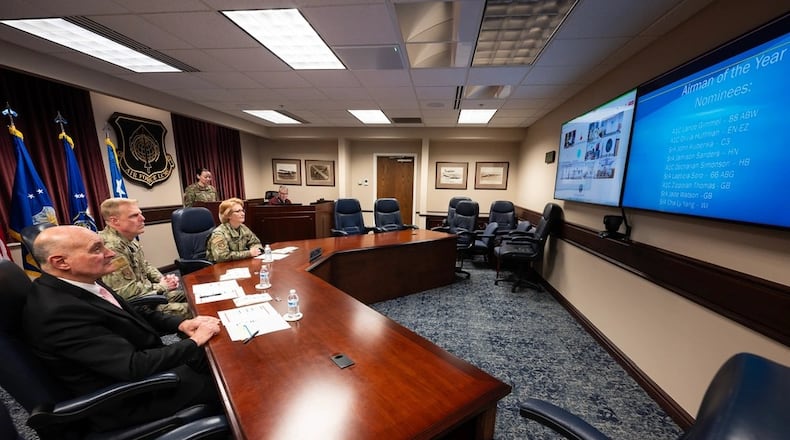The memo proposes the nomination of an O-10 or flag officer —equivalent to a four-star general in the Air Force — to oversee the delivery of critical weapons, with authority over the Air Force Life Cycle Management Center, the AFLCMC Development Office and the Air Force Rapid Capabilities Office.
AFLCMC is headquartered at Wright-Patterson, with about 9,940 employees at the base, including the 88th Air Base Wing.
Some 40% of the Air Force budget flows through Wright-Patterson.
Hegseth’s memo, dated Aug. 6, does not mention Wright-Patterson. But it’s unclear what such a reorganization might mean for AFLCMC’s presence or employment at Wright-Patt. The memo proposes putting the new officer overseeing weapons in the Pentagon in Arlington, Va.
The memo also directs the new officer to “identify and maintain secure offices within the Pentagon in Washington, D.C. and facilities in other locations as necessary (to include staff parking).”
Reduction of duplication
A Pentagon official granted anonymity to discuss unclassified but sensitive information said: “The department is still working through details and the implementation of the new office, but the plan is for the workforce to remain where it is.”
This official noted that the memo calls for “administrative management” for major weapons systems to remain with AFLCMC, the Air Force Rapid Capabilities Office, the Army Corps of Engineers and similarly situated commands.
While AFLCMC will still provide administrative management, program executive officers will report to the newly nominated O-10 instead of the service acquisition executive, this official said.
A number of critical program offices overseeing critical weapons are located at Wright-Patterson or have teams there, including the Bombers Directorate and the Fighters and Advanced Aircraft Directorate.
Jeremiah Gertler, senior associate with the Center for Strategic and International Studies’ Aerospace Security Project, sees the overarching goal as dealing with duplication among the services in what weapons they develop.
“When each service is in charge of its own plans, it’s possible for them to — deliberately or accidentally — go down some of the same roads,“ Gertler told the Dayton Daily News. ”By having a centralized view of what is going on across the services, duplication can be minimized and (at least the thought is) it’ll be easier to share lessons learned and knowledge gained."
That could result in fewer workers, not just at Wright-Patterson, but in other services’ research and development missions as well, he acknowledged.
“But it’s not really possible to tell the effects until we see what it is they are really trying to do and how they are trying to do it,” he said. “Which is a discussion not just for DOD, but the Congress as well.”
U.S. Rep. Mike Turner, R-Dayton, said he was looking into what the memo means for Wright-Patterson
“I have been made aware of this memo and am working to determine what the implications are specifically for Wright-Patterson Air Force Base,” said Turner, a senior member of the House Armed Services Committee. “I remain focused on the missions and advocating for our strong workforce, the men and women who perform the important work of protecting our national security.”
‘A national-level effort’
The memo, which the Dayton Daily News obtained, says the general overseeing the acquisition of weapons “will have direct hire authority to establish and sustain high-performance teams” for the weapons programs.
“Executing this authority will require full support from all DOD (Department of Defense) components, with administrative support from the (Office of the Under Secretary of Defense for Acquisition and Sustainment), the Air Force Materiel Command and the” Secretary of the Air Force for Acquisition.
Air Force Materiel Command is also headquartered at Wright-Patterson. When Gen. Duke Richardson retired as AFMC commander this summer, he was not replaced with another four-star general. There have been local and state concerns about where that leaves AFMC.
The O-10 would be aided “by a hand-selected staff” and administratively supported by the Office of the Under Secretary of Defense for Acquisition and Sustainment.
“This alignment ensures the appropriate consideration of existing and cutting-edge capabilities to the CMWS (critical major weapons systems) programs,” the memo says.
The general would be expected to “immediately establish an agile and highly specialized team with funding support from the CMWS programs,” it adds.
The O-10 — called the “DRPM-CMWS” for Direct Reporting Portfolio Manager-Critical Major Weapon Systems — would possess “major decision authority,” and could, if authorized, act as the senior procurement executive overseeing weapons systems.
“The CMWS are a national-level effort whose success depends on the whole of DOD coming together as an integrated team,” the memo adds. “I ask that all DOD components, staffs, and military services lean forward and provide all required support, facilities and resources as directed or requested to the DRPM-CMWS to ensure success of these critically important programs in defense of the nation.”
Michael Gessel, vice president of federal government programs for the Dayton Development Coalition, said he could not answer questions.
“We can’t comment on the memo, which has not been formally made public,” a spokeswoman for the coalition said.
Wright-Patterson is home not only to AFMC and AFLCMC, but is the headquarters of Air Force Research Laboratory, the National Air and Space Intelligence Center, the National Space Intelligence Center and other missions.
Before the reduction of federal workforces this year, Wright-Patterson had about 38,000 military and civilian employees, making it the largest center of employment in one location in the state of Ohio.
About the Author



